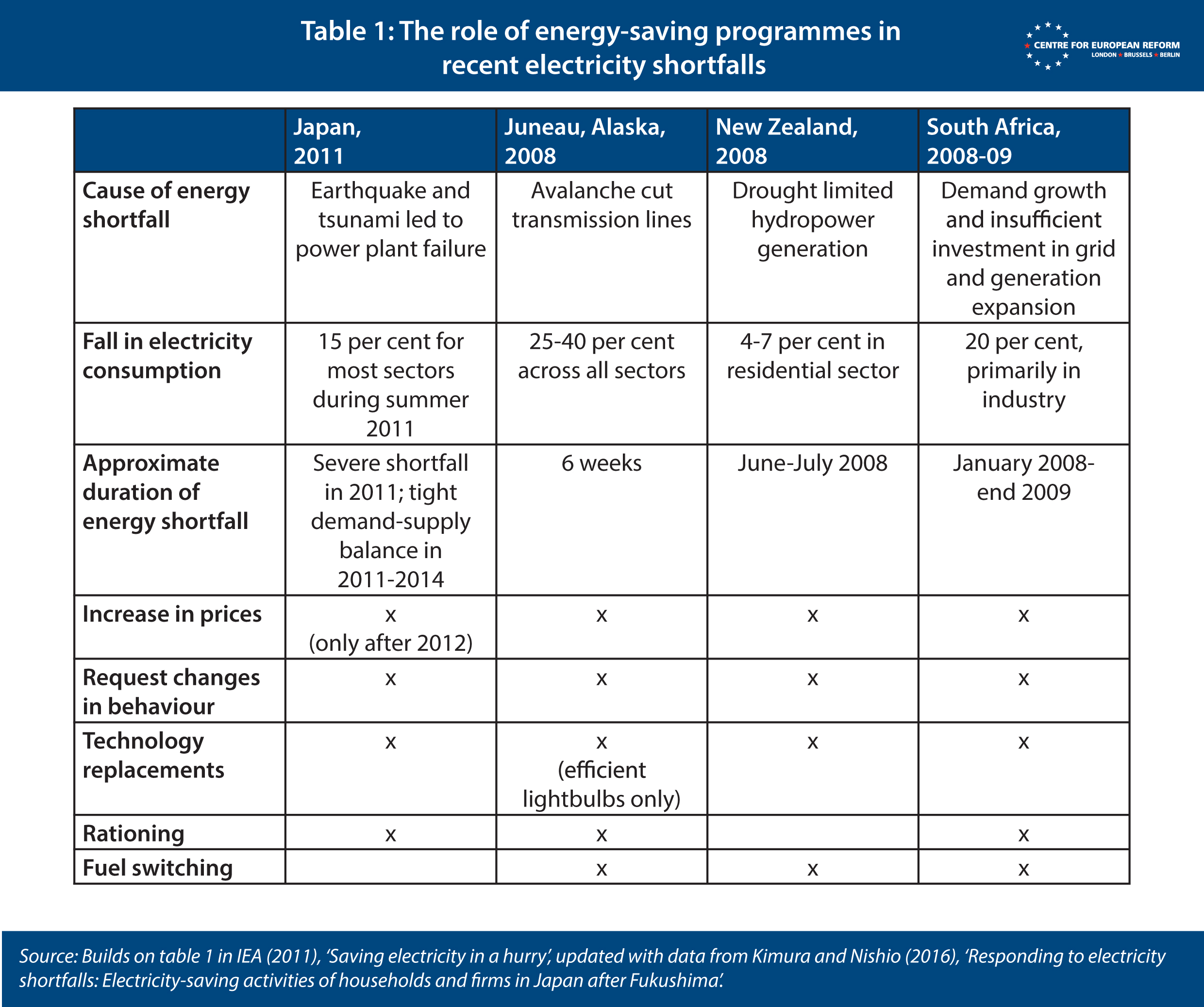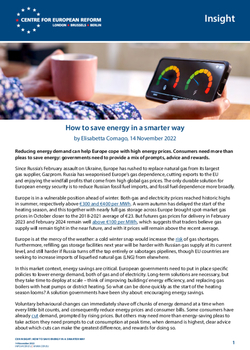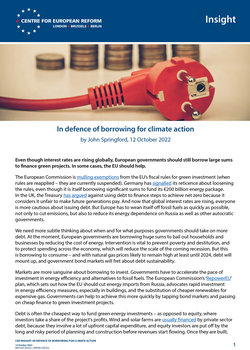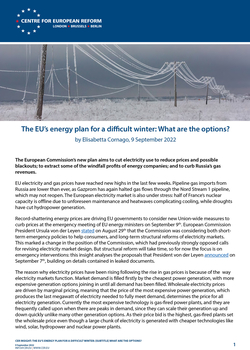
How to save energy in a smarter way
Reducing energy demand can help Europe cope with high energy prices. Consumers need more than pleas to save energy: governments need to provide a mix of prompts, advice and rewards.
Since Russia’s February assault on Ukraine, Europe has rushed to replace natural gas from its largest gas supplier, Gazprom. Russia has weaponised Europe’s gas dependence, cutting exports to the EU and enjoying the windfall profits that come from high global gas prices. The only durable solution for European energy security is to reduce Russian fossil fuel imports, and fossil fuel dependence more broadly.
Europe is in a vulnerable position ahead of winter. Both gas and electricity prices reached historic highs in summer, respectively above €300 and €400 per MWh. A warm autumn has delayed the start of the heating season, and this together with nearly full gas storage across Europe brought spot-market gas prices in October closer to the 2018-2021 average of €23. But futures gas prices for delivery in February 2023 and February 2024 remain well above €100 per MWh, which suggests that traders believe gas supply will remain tight in the near future, and with it prices will remain above the recent average.
Europe is at the mercy of the weather: a cold winter snap would increase the risk of gas shortages. Furthermore, refilling gas storage facilities next year will be harder with Russian gas supply at its current level, and still harder if Russia turns off the tap entirely or sabotages pipelines, though EU countries are seeking to increase imports of liquefied natural gas (LNG) from elsewhere.
In this market context, energy savings are critical. European governments need to put in place specific policies to lower energy demand, both of gas and of electricity. Long-term solutions are necessary, but they take time to deploy at scale – think of improving buildings’ energy efficiency, and replacing gas boilers with heat pumps or district heating. So what can be done quickly as the start of the heating season looms? A solution governments have been shy about: encouraging energy savings.
Voluntary behavioural changes can immediately shave off chunks of energy demand at a time when every little bit counts, and consequently reduce energy prices and consumer bills. Some consumers have already cut demand, prompted by rising prices. But others may need more than energy-saving pleas to take action: they need prompts to cut consumption at peak time, when demand is highest, clear advice about which cuts can make the greatest difference, and rewards for doing so.
The context
The residential sector is the EU’s largest user of gas (40 per cent of gas in Europe is used to heat buildings), followed by industry and the electricity sector. But gas prices in the EU, now over five times their pre-2021 levels, have already started to affect consumption. EU gas demand so far in 2022 is estimated to have dropped by 7 per cent relative to the 2019-2021 average, and by 23 per cent in August. The drop has been mainly driven by cuts in industry, where gas has been replaced with other fossil fuels as far as possible, though some energy-intensive businesses like glass and chemicals manufacturing are temporarily halting or reducing production.
Electricity generation is also adapting: despite high carbon prices, coal-fired power plants are currently cheaper to operate than gas-fired power plants, and have been making a comeback. At the same time, the power system is under additional stress due to lower hydropower generation, caused by this summer’s drought, and lower nuclear power generation, caused by unplanned maintenance across the nuclear fleet in France. Because of the way electricity markets function, using gas-fired power plants has been driving up electricity prices. Electricity demand is filled firstly by the cheapest power generation, with more expensive options joining in until all demand has been filled. To steer supply, the price of the most expensive power generation, which produces the last megawatt of electricity needed to fully meet demand, determines the price for all electricity generation. Currently the most expensive generation technology is gas-fired power plants, and they are frequently called upon when there are peaks in demand, since they can scale generation up and down quickly. As their price bid is the highest, gas-fired plants set the wholesale price even though a large chunk of electricity is generated with cheaper technologies like wind, solar, hydropower and nuclear power plants. This means that curbing electricity demand at peak times is important to save gas, too.
Since the summer, EU leaders have approved emergency energy savings targets for both gas and electricity: while these targets are voluntary and come with exemptions, they are a step forward in that they acknowledge the necessity to cut energy demand in the coming winter and beyond. EU member-states have committed to cutting gas consumption by 15 per cent between August 2022 and March 2023 relative to average consumption in the past five years. Similarly, leaders have agreed to voluntarily cut electricity consumption by 10 per cent over the same period, and mandatorily by 5 per cent at times of peak demand, when the electricity grid is under most pressure.
How can governments effectively encourage households to save energy?
Governments have been developing energy saving plans at national level to translate EU-level targets into actions. But these plans are heavier on pleas (to lower thermostats, for example) and bans (such as restrictions on public lighting at certain times of the night) than on explicit rewards. Facing the risk of gas shortages and electricity blackouts, governments should deploy information campaigns to build a sense of urgency; clear and actionable energy saving tips; and incentives to reward consumers for reducing their energy consumption (beyond bill reductions).
So far European governments’ plans for encouraging energy savings have been heavier on pleas and bans than rewards.
We know from previous information campaigns that they can help cut energy use in the context of crises. For example, after the 2011 earthquake and tsunami hit the Fukushima nuclear power plant in Japan, electricity generation dropped as the Japanese government required all nuclear plants to shut down for maintenance. To make up for the shortfall in electricity supply, the government launched an emergency energy plan to minimise blackouts in affected regions, including Tokyo. This required large commercial and industrial consumers to cut their energy consumption, but also involved an information campaign to encourage households to save energy. Overall, the plan led to 15 per cent less electricity being used in 2011 relative to 2010 in the most affected regions. In summer 2011, large commercial and industrial consumers in Tokyo reduced their electricity consumption by 27 per cent, small ones by 19 per cent and households by 11 per cent relative to 2010. Results were sustained years later: in summer 2014, households consumed 18 per cent less electricity than in 2010.
While the post-Fukushima information campaign is the most recent and best-known example, other public communication efforts have been successful in driving behaviour change to avoid large blackouts, as Table 1 illustrates.

Successful energy-saving campaigns have provided a set of clear and actionable tips. In post-tsunami Japan, alongside its information campaign, the Japanese government provided small commercial and industrial consumers with technical support to identify the best ways to save energy, with engineers visiting 150,000 sites and holding 10,000 workshops. Government and energy utilities also disseminated checklists of energy saving tips. More recently, the innovation NGO Nesta has provided British consumers with step-by-step instructions to lower gas boiler temperatures, which saves gas by slightly reducing the temperature of hot water. Britain’s Behavioural Insights Team has published energy-saving suggestions for households, indicating how much consumption each suggestion is likely to cut, which helps consumers prioritise them. Over winter 2021-2022, UK-based energy utility Octopus launched a ‘winter workout’ which prompted consumers to save gas with reminders and tips: this helped cut the average gas bill by 12 per cent.
Prompts to save electricity should be timely. In France, an electricity forecast, alongside televised weather forecasts, alerts consumers about pressure on the power grid, informing them when their energy-saving efforts would be helpful to avoid shortages. During a recent heatwave, California averted blackouts by prompting consumers to reduce electricity consumption at peak times with a SMS.
In France, an electricity forecast alerts consumers about pressure on the power grid, informing them when their energy-saving efforts would be helpful to avoid shortages.
High energy prices motivate consumers to cut energy consumption so to keep their bills under control. But explicit rewards can prompt more consumers to change their consumption behaviour to cut energy use, recompensing them for the value that individual energy savings provide to the grid. Industrial users are already bidding in auctions to receive rewards if they promise to reduce their electricity consumption at peak times, and consequently gas consumption too. A similar approach could be extended to households and smaller businesses: in North America and Australia, utilities routinely prompt consumers to temporarily reduce their consumption at peak time in exchange for rewards and discounts. For example, in Australia, a utility company paying consumers to save energy when the grid was under stress managed to cut power consumption by up to 42 per cent over three-hour periods at peak time.
To face the current crisis, several utilities in the UK have announced pay-to-save-energy schemes together with the electricity system operator National Grid. For example, Octopus announced rewards for consumers committing and delivering energy savings at peak time. Their earlier trials prompted consumers to cut evening-peak electricity use, in exchange for free consumption for two hours. Consumption went down by 18 per cent on average, but two-thirds of consumers reduced it by up to 30 per cent. Similarly, Ovo has calculated that households use 19 per cent of their overall daily electricity between 4 and 7pm, and launched a scheme rewarding consumers to cut evening electricity use so as to bring this below 12.5 per cent.
These utilities have focused on consumers with smart meters, which allow energy providers to track electricity consumption over the day in order to reward consumers who cut back at the time when it matters the most. Given the emergency situation, utilities could also design alternative strategies to involve consumers that don’t currently have smart meters: asking consumers to read and report their meters more frequently via online forms could be a simple way to engage them and prompt energy savings.
Going forward, getting consumers to save energy, especially at peak times, will be easier with smart meters. Thanks to their granular data collection, smart meters can enable energy providers to offer time-varying tariffs and incentives that better match the generation patterns of renewables, and reduce the need to fire up fossil-based power generation. This can keep both prices and emissions low, and reduce pressure on the grid. Smart meters also allow utilities to provide feedback to consumers on their energy consumption patterns, both in real time and across seasons, and compared to their peers. This type of feedback can drive energy savings, and it helps consumers to better understand how their consumption varies throughout the day and across seasons and appliances.
The electricity smart meter rollout in Europe has been slow, and uneven across countries: the latest cross-country data indicate that 34 per cent of metering points in the EU had a smart meter in January 2018, but while the target for deployment by 2020 was to reach 72 per cent, this was almost certainly missed. The rollout of smart gas meters has been even slower. In January 2018, only a handful of countries including Finland, Italy, Spain and Sweden had already provided smart meters to virtually all consumers. More recent national-level data shows some progress has been made: while France and the UK hovered around a 20 per cent smart meter rollout in early 2018, France had replaced almost 80 per cent of old meters in late 2021, and this figure was 52 per cent in Great Britain. Germany started its rollout only in December 2018, and is now planning to boost this effort. Smart metering needs to become commonplace in Europe as we move towards large-scale electrification and towards a greater role of renewables in the energy mix.
Recommendations
To meet EU-wide emergency targets for the reduction of electricity and gas demand, member-states should, together with local authorities and energy regulators, launch information campaigns that provide actionable tips rather than pleas. Campaigns can guide consumers to cutting energy consumption especially at peak times, and to help them understand how individual efforts can contribute to alleviating shortage risks. Governments should encourage utilities to set up incentive schemes to reward energy savings.
The weakness with EU energy savings targets is that they are largely voluntary: as Europe will face gas shortage risks next winter as well, the EU may need to extend such emergency targets to 2024. EU governments should also acknowledge the tension between energy saving targets and the flurry of policies implemented in the past year to shield consumers from increasing energy prices. Vulnerable consumers need financial support, but untargeted price caps or cuts to energy taxes can go against energy-saving efforts, at a large cost for public budgets.
Amid the energy crunch, EU governments should accelerate investments that can durably reduce demand, like energy-efficient building refurbs, and infrastructure that can help households track their consumption, like smart meters.
Looking forward, EU governments should use the energy crunch as a turning point to accelerate investments that can durably reduce energy demand: these include energy efficient renovations of buildings, and the rollout of smart meters. The EU can encourage a shift to smarter energy savings by building upon its recent action plan for the digitalisation of the energy sector, which calls for faster deployment of smart meters. As co-legislators are negotiating revised energy efficiency targets for 2030, they should also highlight the potential of consumer demand response and pay-to-save energy schemes for European energy security and for the energy transition.
Russia will have less leverage over the EU if the EU is no longer as reliant on its fossil fuels, in particular gas. And the EU will be better able to push back by providing consumers with smarter options to control their energy consumption.
Elisabetta Cornago is a senior research fellow at the Centre for European Reform.




Add new comment